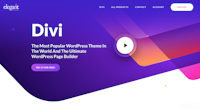Divi WordPress Theme Review
July 6, 2020

To be fair, this isn’t really a review, but more like a perspective. The Elegant Themes Divi web page got me thinking about the myriad ways websites are built.
Over at Ronningen Design we have an amazing process for crafting a custom website. There’s the initial exploratory stage where content is figured out, branding is nailed down, and design direction is established. This is followed by mockups, coding, page crafting, and finally the client is trained to use Typewriter so they can manage their website. It’s a process we’ve worked on for over 20 years, but there are lots of other ways to get the job done.
Many web design shops use WordPress. They have front end developers who take the mockups designed by designers, wrestle with WordPress until they get everything working, and then the client is handed a site that they may or may not be able to manage. While I can’t speak to anyone else’s process, I’m can say there are lots of frustrated website owners out there. Why? Because they don’t feel comfortable making changes to their website, even with a content management system like WordPress on the back end.
Freelancers have to wear the designer hat and the developer hat. Divi looks like a great tool for the solo freelancer, but it still leaves the website owner in the position of having to use an overly complex tool to get the job done.
Divi is a WordPress design tool.
Watching the video they talk about Divi’s big strength — it’s a visual WordPress theme designer. “Everything is drag and drop and totally customizable… shape, size, font, color…” They go on to say, “So now, building a website really is like painting a masterpiece.”
If you’re a designer who doesn’t know how to write code, this sounds pretty good. If you’re not a designer, this sounds like trouble.
Too many options can be overwhelming.
Most website owners are not designers. Most of us are busy operating our businesses or leading our organizations. This is why we decided to do things differently. Typewriter’s ready-made website designs set you free from the fine-grained design decisions. It’s 100% OK that you aren’t a designer. I’m not a plumber. I can replace a faucet but that doesn’t mean I can do all of the plumbing for my home. My lack of knowledge and experience makes it impossible for me to do a great job! That’s life. I need plumbing that works and you need a website that works.
As the website owner, Typewriter lets you skip from “I need a website” to working on your website, without a design or development process in the middle. No mockups to review. No back and forth with a designer, change requests, development headaches, or anything else! Just dive in and work on your content.
Protect your brand by keeping things consistent.
Inconsistency is the enemy of strong branding. Changing colors here and there, using different fonts depending on your mood, changing shapes and sizes — these are all things that result in an inconsistent brand, and that erodes trust. Having something like Divi in front of you is almost a temptation to make changes, and that’s what happens on so many websites. One change here, another there, and before you know it the website feels like a hodge podge.
Constraints make it easier to get things done.
When the design is done you’re free to focus on your message. Working in Typewriter is different from working in WordPress or Divi because you’re only focused on one thing at a time. You’re crafting the content of your page — that’s it.
You have a variety of pre-designed blocks that work well together, so your page will have visual variety, but you’re not having to think about the fonts for your headlines, the colors for your backgrounds, shapes, sizes, or anything else. That’s just too much to do at once!
Divi is probably great for people who want to use WordPress.
Really, I’ll bet it is wonderful… but I’m going to say no to the security issues, plug-in conflicts, regular WP updates, and all of the other headaches that come with using the world’s most popular platform. If you’re a designer and you’re reading this, think about what’s best for your client. Will they be happy with all of that freedom, or are they just interested in having a professional website that they can manage themselves?
